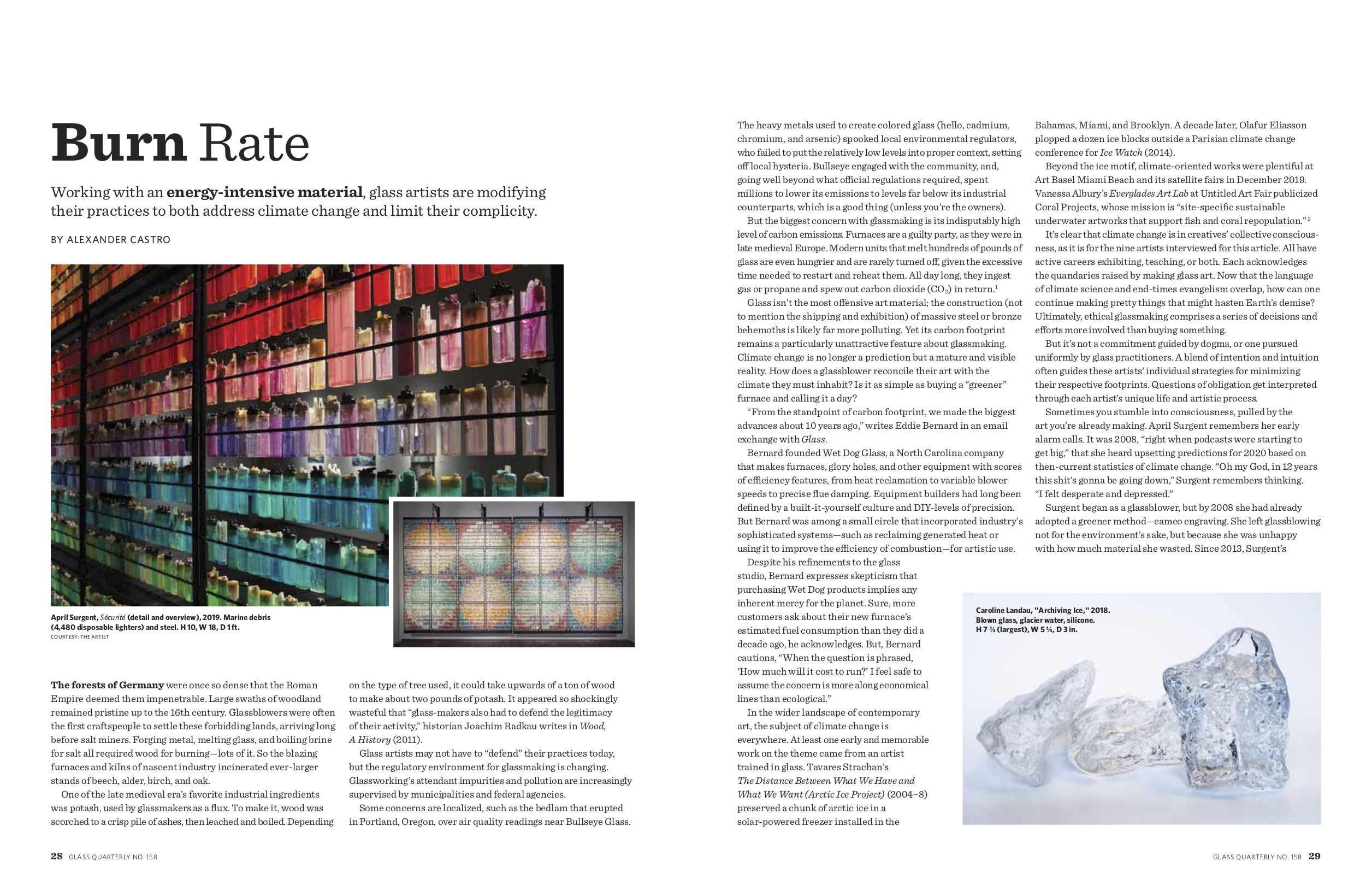The Spring 2020 edition of Glass: The UrbanGlass Art Quarterly (#158) is hitting newsstands and subscriber mailboxes. On the cover is a stained-glass light box by Judith Schaechter titled Murdered Animal (2019), at its centerpiece a mortally wounded feline creature rendered in a stack of stained glass images. The multiple layers allow a level of detail in the ripple of sinewy muscles or vertebral lumps on this animal body curled into a fetal position and cocooned in a womb-like refuge. The animal sports multiple wounds, defined by scarlet drops of blood that pick up the red-hues of the surrounding tapestry-like quasi-decorative field that also resembles a network of vein-like stems, perhaps umbilical connections between the victim and the fertility of the natural world. The richness of this work, and its central theme of nature under assault, make it as timely as it is visually compelling.

Timed to the first-ever museum retrospective of Judith Schaechter's career ("The Path to Paradise" is now on view at the Memorial Art Gallery in Rochester, New York, after which it will tour to the Toledo Museum of Art later this year and the Des Moines Art Center in 2021), the Glass cover article traces Schaechter's evolution from a painting student at RISD to one of the major innovators in the history of stained-glass. "One of the things that felt authentic to me was I wanted to work from my imagination," Schaechter told Glass, in the context of her struggles with the blank canvas versus the demanding medium of glass. "Painting was a quick thing — I wasn't able to be attached — but the glass took forever."
 Schaechter is increasingly turning her attention to climate change as a theme in her newest work, and she is not alone. In his feature article entitled "Burn Rate," regular Glass contributor Alexander Castro surveys the field and finds that glass artists are well-aware they work with an energy-intensive material, and are modifying their practices to both address climate change and limit their complicity. Castro references Eddie Bernard, Sarah Briland, Julie Conway, Olafur Eliasson, Katherine Gray, Caroline Landau, April Surgent, Tavares Strachan, Norwood Viviano, and David Willis in his exploration of this urgent topic.
Schaechter is increasingly turning her attention to climate change as a theme in her newest work, and she is not alone. In his feature article entitled "Burn Rate," regular Glass contributor Alexander Castro surveys the field and finds that glass artists are well-aware they work with an energy-intensive material, and are modifying their practices to both address climate change and limit their complicity. Castro references Eddie Bernard, Sarah Briland, Julie Conway, Olafur Eliasson, Katherine Gray, Caroline Landau, April Surgent, Tavares Strachan, Norwood Viviano, and David Willis in his exploration of this urgent topic. 
Contributing editor John Drury presents an in-depth interview with fraternal collaborators Einar and Jamex de la Torre, who shuffle visual icons of folklore, pop culture, religion, and current events in their latest work, which also manages to incorporate large-scale lenticular printed elements that channel their outrage at the state of politics. In addition to their glass elements, the brothers (who answer as a single entity "De la Torres") have been incorporating wallpaper into their installations for the past 10 years. "The use of wallpaper started over a decade ago as we fell in love with the way it immerses viewers in our layered architecture while still being relatively affordable for impermanent exhibitions."

Jaime Guerrero grew up in East Los Angeles in the 1970s and 80s, where he had to navigate a dangerous urban environment defined by shootings, fights, gang intimidation, and police brutality, according to article author D Wood, a widely-published writer on art and design. Guerrero first encountered glass as a student at the California College of Arts and Crafts, and he would go on to become expert in traditional techniques at the same time as applying them to thoroughly contemporary subject matter. He has most recently focused on the issue of migrant detention, an issue of particular resonance as his own parents immigrated from Mexico. Using blowing and hot-working techniques, Guerrero has made a series of near-life-sized portraits of bereft children separated from their parents at the southern border of the U.S.

The final feature in the Spring 2020 edition is by well-known flameworker Shane Fero, who offers an in-depth look at the life and work of Sally Prasch, who is being honored this month by the International Flameworking Conference, where she is the featured artist. As a teenager, Prasch apprenticed for a scientific glassblower at the University of Nebraska, where she was not only exposed to the world of flameworking but also the challenges of an African-American artist making his way to weekend art fairs. This helped Prasch to develop a highly-tuned sense of justice, which helped her to navigate a long career in the world of laboratory glass, where she faced repeated discrimination as a female. She channels her outrage in some of her artistic works, and has committed herself to battling injustice through her activism as well as her artwork.
All this, plus an essay on Liza Lou's Whitney Museum installation of The Kitchen (1991-96); reviews of the permanent collection at the Museum of Glass in Tacoma, Washington; painter Joanne Greenbaum's foray into glass fusing, and Fred Wilson's "Chandeliers" at Pace Gallery.
Finally, the issue's "Reflection" back-page essay honors the late Muranese Maestro Checco Ongaro (1929 - 2020), for which former Glass Art Society executive director Pamela Koss interviewed Jamie Carpenter, Dan Dailey, Dick Marquis, Benjamin Moore, Lino Tagliapietra, and Toots Zynsky to share recollections on the first Maestro to open the door to Venetian traditional techniques and to consider about how a single personality changed the course of glass-art history.
NOTE: The feature articles and reviews in the print edition of Glass are not available on the Hot Sheet blog. Don't miss a single issue of the print or digital edition. Subscribe today.



